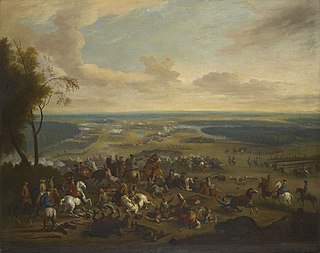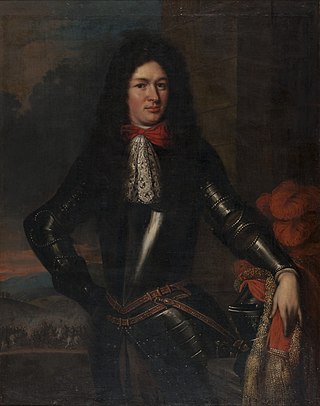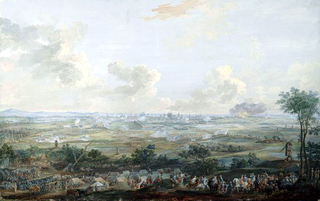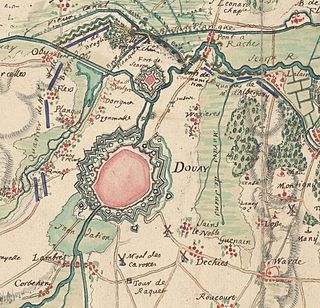
Prince Eugene Francis of Savoy-Carignano, better known as Prince Eugene, was a distinguished field marshal in the Army of the Holy Roman Empire and of the Austrian Habsburg dynasty during the 17th and 18th centuries. Renowned as one of the greatest military commanders of his era, Prince Eugene also rose to the highest offices of state at the Imperial court in Vienna spending six decades in the service of three emperors.

John William Friso became the (titular) Prince of Orange in 1702. He was the Stadtholder of Friesland and Groningen in the Dutch Republic. He also served in the Dutch States Army during the War of the Spanish Succession until his death by accidental drowning in the Hollands Diep in 1711.

General John Churchill, 1st Duke of Marlborough, 1st Prince of Mindelheim, 1st Count of Nellenburg, Prince of the Holy Roman Empire, was an English soldier and statesman. From a gentry family, he served as a page at the court of the House of Stuart under James, Duke of York, through the 1670s and early 1680s, earning military and political advancement through his courage and diplomatic skill. He is known for never having lost a battle.

The Battle of Denain was fought on 24 July 1712 as part of the War of the Spanish Succession. It resulted in a French victory, under Marshal Villars, against Dutch and Austrian forces, under Prince Eugene of Savoy.

The Battle of Malplaquet took place on 11 September 1709 during the War of the Spanish Succession, near Taisnières-sur-Hon in modern France, then part of the Spanish Netherlands. A French army of around 75,000 men, commanded by the Duke of Villars, engaged a Grand Alliance force of 86,000 under the Duke of Marlborough. In one of the bloodiest battles of the 18th century, the Allies won a narrow victory, but suffered heavy casualties.

Claude Louis Hector de Villars, Prince of Martigues, Marquis then (1st) Duke of Villars, Viscount of Melun was a French military commander and an illustrious general of Louis XIV of France. He was one of only six Marshals to have been promoted Marshal General of France.

Louis François de Boufflers, Duke of Boufflers was a prominent French soldier in the age of Louis XIV of France. He was created count of Cagny and duke of Boufflers and named marshal of France. He was famed for his excellent defensive leadership during the sieges of Namur and Lille, next to his conduct during the Battle of Malplaquet.

The siege of Bouchain, following the Passage of the Lines of Ne Plus Ultra, was a siege of the War of the Spanish Succession, and the last major victory of John Churchill, 1st Duke of Marlborough. Marlborough and François Nicolas Fagel broke through the French defensive lines and took Bouchain after a siege of 34 days. Its capture left Cambrai the only French-held fortress between the allied army and Paris.

The Battle of Ekeren, which took place on 30 June 1703, was a battle of the War of the Spanish Succession. A Bourbon army of around 24,000 men, consisting of troops from France, Spain and Cologne, surrounded a smaller Dutch force of 12,000 men, which however managed to break out and retire to safety.

The siege of Mons, 15 March – 10 April 1691, was a major operation fought during the Nine Years' War, and was the main French objective for the 1691 campaign in the Spanish Netherlands. The city was besieged and captured before the normal commencement of the campaigning season with minimal losses. The outcome was not in doubt, but in a conflict dominated by siege warfare, neither the French army of King Louis XIV, nor the forces of the Grand Alliance under King William III, could bring about a decisive battle. After the siege the duc de Boufflers bombarded the neutral city of Liège, whilst the duc de Luxembourg captured Halle, and scored a minor victory against the Prince of Waldeck at the Battle of Leuze in September. Strategically, however, little had changed in the war, and both combatants returned to winter quarters at the end of the campaigning season.

The siege of Lille was the main operation of the 1708 campaign season during the War of the Spanish Succession. Following their victory in the Battle of Oudenaarde, the Allies decided to besiege Lille, an important French city and perhaps the strongest fortress in Europe. After an obstinate defence of 120 days, the French garrison surrendered the city and citadel of Lille, commanded by Marshal Boufflers, to the forces of the Duke of Marlborough and Prince Eugene.

François Nicolas Baron Fagel was a Dutch States Army officer and nobleman. He was a nephew of Gaspar Fagel and took part in many battles during his career. As an infantry officer, he played an important role several battles, including the Battle of Landen, the Battle of Ekeren and the Battle of Malplaquet. From 1704 to 1705, he commanded, Allied forces in Portugal in concert with the Earl of Galway. He also was a siege expert and led the sieges of Béthune, Bouchain and Le Quesnoy in 1710, 1711 and 1712 respectively. He was the son of Nicolaas Fagel, mayor of Nijmegen, and Elisabeth Robbé.

The siege of Bouchain, was a siege of the War of the Spanish Succession, and a victory for the French troops of the Duc de Villars. A French army of 20,000 men besieged and captured the Allied-controlled fortifications after an 18-day siege, with the 2,000-strong Dutch-Imperial garrison under Major-General Frederik Sirtema van Grovestins capitulating on 19 October.

Henry Withers was a British army officer and politician, who began his career in 1674 during the Franco-Dutch War and reached the rank of Lieutenant General in 1707. A close associate of the Duke of Marlborough during the War of the Spanish Succession, he served in a number of actions, including the 1704 battles of Schellenberg, Blenheim, and Malplaquet in 1709.

Claude Frederic t'Serclaes, Count of Tilly was a Dutch States Army officer and nobleman. He took part in the Franco-Dutch War, Nine Years' War and the War of the Spanish Succession and proved a brave and capable cavalry general. In 1708 he became the de facto supreme commander of the Dutch army, and led the Allied forces together with the Duke of Marlborough and Eugene of Savoy.

The siege of Tournai was a two-month siege of the city and citadel of Tournai, then part of the Austrian Netherlands, in 1745 during the War of the Austrian Succession. The allied Pragmatic Army's attempt to relieve the siege resulted in the decisive French victory at the Battle of Fontenoy on 11 May. The largely Dutch garrison of the city subsequently surrendered to French forces on 22 May, while the garrison of the citadel surrendered on 19 June 1745. It was one of the longest sieges of the war.

The siege of Tournai was a siege of the city of Tournai, then part of the Kingdom of France, between 28 June and 3 September 1709. A Grand Alliance army under the British Duke of Marlborough successfully forced the surrender of the French garrison during the War of the Spanish Succession.

Daniël Wolf baron van Dopf was a Dutch States Army officer and nobleman. He was, among other things, general of the cavalry of the Dutch army during the War of the Spanish Succession, Quartermaster general of that army, and later commander and governor of the fortress of Maastricht.

The siege of Douai, which lasted from 22 April 1710 until the capitulation of the garrison under lieutenant-general François Zénobe Philippe Albergotti on 25 June 1710 was part of the Allied Campaign of 1710 in the War of the Spanish Succession. The siege was conducted under the joint command of the Princ of Orange and Leopold I, Prince of Anhalt-Dessau and successfully concluded despite the fact that halfway through the French army under marshal Claude Louis Hector de Villars, 1st Duke of Villars made an attempt to relieve the fortress city, which led to an indecisive stand-off for four days with the Allied Army under John Churchill, 1st Duke of Marlborough and Prince Eugene of Savoy. After Douai the Allies went on to besiege Béthune.

The assault on Brussels or siege of Brussels occurred during the War of the Spanish Succession, from 22 to 27 November 1708 involving French and pro-Bourbon Spanish troops under Maximilian of Bavaria against the garrison and citizens of the city of Brussels.





















